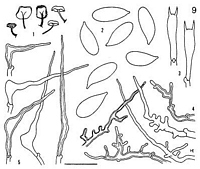|
 Hemimycena hirsuta Hemimycena hirsuta
SynonymsHelotium hirsutum
BiostatusPresent in region - Indigenous. Non endemic
Images (click to enlarge)
Caption: Hemimycena hirsuta (Tode) Singer (PDD, ZT 68-682): 1, basidiomes (x2);
2, basidiospores (x2000); 3, basidia (x1000);
4, pileipellis with pilocystidia (x1000);
5, caulocystidia (x1000). |
Article: Horak, E.; Desjardin, D.E. (1994). Reduced marasmioid and mycenoid agarics from Australasia. Australian Systematic Botany 7: 153-170.
Description: Pileus
to 6 mm diam., hemispheric, soon becoming convex to flat-expanded, centre occasionally
depressed, in mature specimens incurved margin dentate-lobate, white, densely
covered (hand-lens) with white, strigose hairs. Lamellae none, hymenophore smooth
or with few inconspicuous, radially arranged folds, decurrent on stipe, white.
Stipe to 4 X 0.3 mm, central, cylindrical, straight to slightly curved, white,
pruinose to tomentose overall, fragile, dry, solid, solitary in groups, insititious
(byssus or basal disc absent). Odour absent. Basidiospores 9.5-12 X 4- 5 µm,
subfusiform to broadly comma-shaped, inequilateral in side profile, smooth,
hyaline, inamyloid. Basidia 24-30 X 5-7 µm, constantly bisporic, cylindric to
subclavate, sterigmata up to 5 µm long, clamped. Hymenial cystidia absent. Pileipellis
a cutis of entangled hyphae (2.5-7 µm) with wart-like, finger-like or more rarely
coralloid projections, terminal cells erect, 20-90 µm long, with irregular finger-like
projections at base, but smooth towards gradually attenuated tips, non-gelatinous,
thick-walled (up to 2 µm diam.), septa clamped. Oleiferous hyphae absent. Stipe
tissue monomitic. Stipe cortical hyphae smooth to diverticulate, thick-walled
(up to 2 µm), hyaline. Caulocystidia 30-110 X 4-8 µm, scattered, awl-shaped
or fusiform with long tapering neck, thick-walled (up to 2 µm).
Habitat: On rotting leaves of Carex sp. or
Uncinia sp. (Cyperaceae). Known from the South Island of New Zealand.
Notes: This is the first report of Hemimycena
hirsuta (Tode) Singer (sensu Redhead 1981) from New Zealand, which extends
its known area of distribution (Eurasia, Morocco in northern Africa, North America)
to the southern hemisphere
|